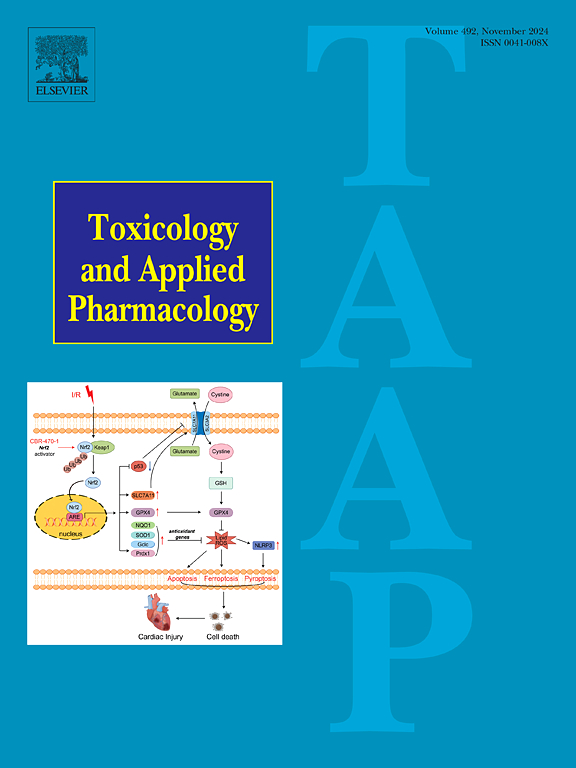几种法尼基氧羧甲酰基衍生物作为前列腺癌治疗的15-LOX-1抑制剂的评价。
IF 3.3
3区 医学
Q2 PHARMACOLOGY & PHARMACY
引用次数: 0
摘要
15-脂氧合酶-1 (15-LOX-1)在前列腺癌(PCa)进展中的影响值得注意,因为它与疾病的Gleason评分相关。因此,开发特异性的15-LOX-1抑制剂将是PCa靶向治疗的理想选择。本研究的重点是评估三种法尼基氧基carbostyril衍生物的抗前列腺癌能力,6-,7-和8-法尼基氧基carbostyril(6-, 7-和8-FQ),作为PCa细胞15-LOX-1的潜在抑制剂。为此,我们首先在PCa和人真皮成纤维细胞(HDF)中评估了15-LOX的酶活性,随后分别通过MTT法和FITC-annexin V/PI染色评估了化合物的细胞毒作用和诱导凋亡能力。在这些化合物中,8-FQ被选择用于携带异种移植人PCa肿瘤的小鼠模型的进一步评估。结果表明,在30和14 μM浓度下,最有效的化合物8-FQ分别使PC-3细胞的15-LOX活性降低84倍和15.7倍。MTT实验揭示了化合物对PCa细胞的剂量和时间依赖性毒性,流式细胞术结果表明细胞凋亡是细胞死亡的主要机制。考虑到15-LOX-1在人PCa细胞中的上调,该研究得出结论,对8-FQ的敏感性升高可能与15-LOX-1水平升高有关。体内实验显示,8-FQ在10 mg/kg的剂量下具有较强的抗肿瘤作用,且副作用最小,表明其在进一步优化后可能成为一种有前景的PCa治疗药物。本文章由计算机程序翻译,如有差异,请以英文原文为准。
Evaluation of several farnesyloxycarbostyril derivatives as potential 15-LOX-1 inhibitors for prostate cancer treatment
The impact of 15-lipoxygenase-1 (15-LOX-1) in the progression of prostate cancer (PCa) is noteworthy, as it correlates with the Gleason score of the disease. Thus, development of specific 15-LOX-1 inhibitors would be desirable for targeted therapy of PCa. This study focused on evaluating the anti-prostate cancer potency of three farnesyloxycarbostyril derivatives, 6-, 7- and 8-farnesyloxycarbostyril (6-, 7- and 8-FQ), as potential inhibitors of 15-LOX-1 on PCa cells. To this end, the enzymatic activity of 15-LOX was first assessed in PCa and human dermal fibroblast (HDF) cells. Subsequently, the cytotoxic effects and apoptosis-inducing capabilities of the compounds were assessed through MTT assay and FITC-annexin V/PI staining, respectively. Among the compounds, 8-FQ was selected for further assessment in a mouse model bearing xenograft human PCa tumor. The results demonstrated that the most effective compound, 8-FQ, caused an 84-fold and 15.7-fold reduction in 15-LOX activity in PC-3 cells at 30 and 14 μM concentrations, respectively. The MTT assay revealed a dose- and time-dependent toxicity of the compounds on PCa cells, and flow cytometry results indicated that apoptosis served as the dominant mechanism of cell death. Given the upregulation of 15-LOX-1 in human PCa cells, the study concludes that the heightened sensitivity to 8-FQ is likely associated with elevated levels of 15-LOX-1. In vivo experiments using immunosuppressed C57BL/6 mice bearing human PC-3 tumors revealed that 8-FQ, at a dosage of 10 mg/kg, exhibited strong antitumor effects with minimal side effects, indicating its potential as a promising therapeutic agent for PCa following further optimization.
求助全文
通过发布文献求助,成功后即可免费获取论文全文。
去求助
来源期刊
CiteScore
6.80
自引率
2.60%
发文量
309
审稿时长
32 days
期刊介绍:
Toxicology and Applied Pharmacology publishes original scientific research of relevance to animals or humans pertaining to the action of chemicals, drugs, or chemically-defined natural products.
Regular articles address mechanistic approaches to physiological, pharmacologic, biochemical, cellular, or molecular understanding of toxicologic/pathologic lesions and to methods used to describe these responses. Safety Science articles address outstanding state-of-the-art preclinical and human translational characterization of drug and chemical safety employing cutting-edge science. Highly significant Regulatory Safety Science articles will also be considered in this category. Papers concerned with alternatives to the use of experimental animals are encouraged.
Short articles report on high impact studies of broad interest to readers of TAAP that would benefit from rapid publication. These articles should contain no more than a combined total of four figures and tables. Authors should include in their cover letter the justification for consideration of their manuscript as a short article.

 求助内容:
求助内容: 应助结果提醒方式:
应助结果提醒方式:


